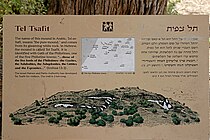
Tel Tsafit (other spellings Tel Tzafit, Tel Zafit or Tell it-Safi or Hebrew תל צפית is a settlement mound and an archaeological site in the Schefela. The archaeological site will be with Gath the Philistines brought into context, the Philistine city of Gath is suspected to be elsewhere.
background


The 213 m above sea level height Tel Tsafit was settled for millennia; Traces of settlement from the Copper Age were uncovered, and a larger urban settlement existed here in the Iron Age.
Archaeologists assume that it is the settlement Gath the Philistines acts, the Philistine city, near which, according to biblical tradition, the duel between David and the Philistine Goliath takes place 1 Samuel 17,4-52 should have occurred. Gath is later mentioned as a refuge by David from the persecution of Saul, in 2 kings 12,18 there is a report that Hasael, king of Aram, has taken the city. Siege traces from the 9th century. B.C. support this hypothesis. So far, however, the proof in the form of an inscription is still pending; from other archaeological groups is near Gath Ramla suspected, however, that it could be another city of the same name. The settlement mounds of Tell 'Areini and Tell en-Nejileh were also discussed as locations of the biblical Gath; these hypotheses were rejected due to the archaeological finds made there.
history
From the Bronze Age traces of a public building and various Egyptian objects were found, including hieroglyphic inscriptions on locally produced ceramics. Apparently the settlement was destroyed by the arriving Philistines.
The Iron Age settlement traces from approx. 1175 BC. go back to the earliest phase of the settlement by the Philistines, in different layers of settlement there were witnesses from the different phases of the Philistine culture. In the 9th century the city was destroyed, on the one hand this was probably due to an earthquake, on the other hand there are traces of a siege with dug trenches and a heaped earth ramp. In 2005, shards with proto-Semitic inscriptions were found, the words ALWT (אלות) and WLT (ולת) indicate that names similar to the name Goliath were in use in the region.
After the destruction, the city no longer regained its former importance, but the area remained populated. At the time of the First Crusade, there was a small crusader hatchery "Blanche Guard" erected (so named because of the white limestone cliffs), Richard the Lionheart was almost captured here during an inspection of his troops. In 1191 the fortress was taken by Saladin's troops.
The Arab agricultural settlement Tell al-Safi was abandoned by the population after the Israeli War of Independence in 1948.
The first investigations of the Tel were carried out in 1899 by the British archaeologists Bliss and Macalister, and systematic excavations were not started until 1996 under Aren Maeir.
landscape
The Tel Tsafit is an elevation with an impressive view of the hilly landscape of the Schefela, the vegetation is Mediterranean. The hill is surrounded by agricultural land, including citrus plantations.
Flora and fauna
The flora is particularly worth seeing in spring, in the months of February and March. On the slopes to the west there is a sparse population of trees.
climate
There is an arid Mediterranean climate, the region receives a little more rainfall than the Negev desert. {{-} {}

getting there
From the main street 40 (Ramla - Kiryat Gat - Beer Sheva) one branches off at the Reem Junction on the 3 eastwards and leaves it a little later to go to the right 1 Junction 383 on the 383 in the direction Bet Schemesch to turn in. After the highway 6 is crossed, 2 Branch turn right at the second street.
The road leads to the nature park Haruvit Forest past, but not to turn off. At the 3 End of the paved road do not turn to the large power station, but follow the gravel road with a few curves. At the end of the wooded area (with picnic tables and playground) the well mobile one leads 4 Dirt road continue in a southerly direction. The 5 parking spot is fringed by field stones.
Fees / permits
No entry fee, staying in the park area at night is prohibited.
mobility
You climb Tel Tzafit on foot, the ascent takes about 15 minutes, the entire circular route is 3 km in length.


Tourist Attractions
- at the starting point of the walk at parking spot there are information boards on the history of the Philistine cities.
- on the ascent to the summit you pass the 1 white limestone cliffswhich gave the crusader fortress the name "Blanche Garde". They show traces of human settlement.
- the footpath leads in an arc over the southern flank onto the 2 Tel TzafitSummit of the settlement hill. Here you can find scant traces of the ancient city, on an information board you can find information about the view over the Schefela to the Judean mountains.
- The footpath continues over the northeast flank to the 3 Ruins of the Philistine City, the excavations are not yet accessible and didactically prepared and can only be seen over the fence.
- the footpath circles the north-east flank in a gentle descent and leads back to the parking lot through a population of trees.
activities

Hiking, the view of the Schefela is worth seeing
shop
No shopping facilities on site, the nearest larger cities with shopping facilities are Ashdod and Bet Schemesch.
kitchen
No catering facilities on site, the nearest larger cities with catering facilities are Ashdod and Bet Schemesch.
accommodation
No accommodation options on site, the nearest larger cities with overnight accommodation are Ashdod and Bet Schemesch.
security
The security situation in the Israeli heartland is harmless.
trips
- is very close by 4 Haruvit Forest with its picnic opportunities, walking paths and bike tracks in the tree shade (located at the entrance to Tel Tsafit) also worth a visit.










